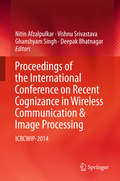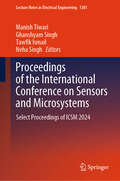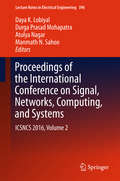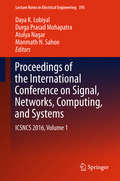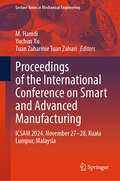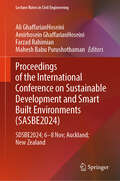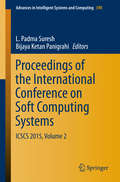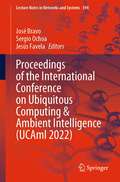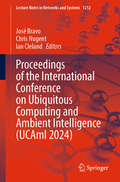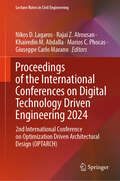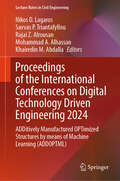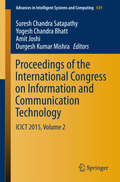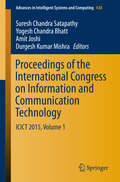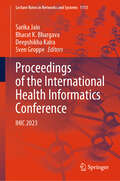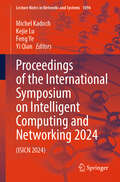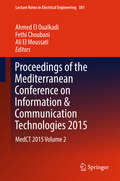- Table View
- List View
Proceedings of the International Conference on Recent Cognizance in Wireless Communication & Image Processing
by Ghanshyam Singh Nitin Afzalpulkar Vishnu Srivastava Deepak BhatnagarThis volume comprises the proceedings of the International Conference on Recent Cognizance in Wireless Communication & Image Processing. It brings together content from academicians, researchers, and industry experts in areas of Wireless Communication and Image Processing. The volume provides a snapshot of current progress in computational creativity and a glimpse of future possibilities. The proceedings include two kinds of paper submissions: (i) regular papers addressing foundation issues, describing original research on creative systems development and modeling; and (ii) position papers describing work-in-progress or research directions for computational creativity. This work will be useful to professionals and researchers working in the core areas of wireless communications and image processing.
Proceedings of the International Conference on Sensors and Microsystems: Select Proceedings of ICSM 2024 (Lecture Notes in Electrical Engineering #1381)
by Ghanshyam Singh Manish Tiwari Tawfik Ismail Neha SinghThis book constitutes peer-reviewed proceedings of the 1st International Conference on Sensors and Microsystems (ICSM-2024). This book discusses the latest technological advancements in designing and implementing sensors and microsystems. The book is a unique collection of chapters from different areas with a common theme. The book covers a broad range of topics relating to sensors and microsystems which includes physics, chemistry, and materials science of the sensors and sensor applications in biomedical, optoelectronic systems, control and verification, automated systems, human-computer interface, etc., with tailored intelligence to make a transformative impact on the economy, industry, and society. It is beneficial for academic researchers and practitioners in the industry who work in this field.
Proceedings of the International Conference on Signal, Networks, Computing, and Systems
by Durga Prasad Mohapatra Atulya Nagar Daya K. Lobiyal Manmath N. SahooThe book is a collection of high-quality peer-reviewed research papers presented in the first International Conference on Signal, Networks, Computing, and Systems (ICSNCS 2016) held at Jawaharlal Nehru University, New Delhi, India during February 25-27, 2016. The book is organized in to two volumes and primarily focuses on theory and applications in the broad areas of communication technology, computer science and information security. The book aims to bring together the latest scientific research works of academic scientists, professors, research scholars and students in the areas of signal, networks, computing and systems detailing the practical challenges encountered and the solutions adopted.
Proceedings of the International Conference on Signal, Networks, Computing, and Systems
by Durga Prasad Mohapatra Atulya Nagar Daya K. Lobiyal Manmath N. SahooThe book is a collection of high-quality peer-reviewed research papers presented in the first International Conference on Signal, Networks, Computing, and Systems (ICSNCS 2016) held at Jawaharlal Nehru University, New Delhi, India during February 25-27, 2016. The book is organized in to two volumes and primarily focuses on theory and applications in the broad areas of communication technology, computer science and information security. The book aims to bring together the latest scientific research works of academic scientists, professors, research scholars and students in the areas of signal, networks, computing and systems detailing the practical challenges encountered and the solutions adopted.
Proceedings of the International Conference on Smart Cities - Volume 2: ICSC 2024, September 10-11, Kota Kinabalu, Malaysia (Lecture Notes in Electrical Engineering #1417)
by Nasir Shafiq Hisham Mohamad Mohd Hilmi Hasan Said Jadid AbdulkadirThis book contains papers presented at the International Conference on Smart Cities (ICSC 2024) under the banner of World Engineering, Science & Technology Congress (ESTCON 2024) held from September 10 to 11, at Sabah International Convention Centre, Kota Kinabalu, Malaysia. The conference contains papers presented by academics and industrial practitioners showcasing their latest advancements and findings in emerging smart cities and sustainable urban living. The papers are categorized under the following tracks and topics of research: (1) Sustainable Engineering for Building; (2) Blockchain and Cybersecurity; (3) Artificial Intelligence (AI); (4) Smart Transportation System; and (5) Low-Carbon Planning for Sustainable City.
Proceedings of the International Conference on Smart and Advanced Manufacturing: ICSAM 2024, November 27-28, Kuala Lumpur, Malaysia (Lecture Notes in Mechanical Engineering)
by M. Hamdi Yuchun Xu Tuan Zaharinie Tuan ZahariThis book presented selected papers from the International Conference on Smart and Advanced Manufacturing (ICSAM) 2024 held during 27-28 November, Kuala Lumpur, Malaysia. The book covers various aspects of design, development, assembly, integration, and verification within the manufacturing domain. The papers cover key topics such as (1) intelligent manufacturing; (2) process optimization; (3) design and fabrication; (4) joining technology; (5) materials processing; (6) materials innovation, bringing together contributions from industry practitioners, academics, and policymakers from different sectors science disciplines to offer a holistic perspective. The papers emphasize on practical case studies and showcase real-world examples of successful smart manufacturing implementations, challenges faced, and lessons learned. It highlights regional differences in smart manufacturing practices, regulations, and cultural nuances and also ethical implications of smart manufacturing technologies such as data privacy, worker safety, and environment. Lastly it dedicates a section to emerging trends and futuristic concepts, such as Industry 4.0, digital twins, blockchain in supply chains, and human–robot collaboration.
Proceedings of the International Conference on Smart and Sustainable Built Environment: SASBE2024, 7-9 November, Auckland, New Zealand (Lecture Notes in Civil Engineering #591)
by Farzad Rahimian Ali GhaffarianHoseini Amirhosein Ghaffarianhoseini Mahesh Babu PurushothamanThis book presents peer reviewed articles from the International Conference of Sustainable Development and Smart Built Environments: SDSBE2024; held from 6-8Nov at Auckland, New Zealand. It encapsulates cutting-edge research in Sustainable Development and Smart Built Environments, featuring global scholars. Encompassing diverse themes, the book explores sustainable urban development, governance, and policy, emphasizing urban greening and climate resilience. It delves into innovative approaches for sustainable transport, intelligent infrastructure, and community well-being. The integration of Data Science, AI, and IoT for optimizing built environments is a focal point, alongside advancements in digital twins and OpenBIM. Social aspects, including equity and indigenous perspectives, are explored, along with health considerations in urban settings. The proceedings serve as a comprehensive resource, reflecting the multifaceted advancements driving sustainable and smart urban futures.
Proceedings of the International Conference on Soft Computing Systems
by Bijaya Ketan Panigrahi L Padma SureshThe book is a collection of high-quality peer-reviewed research papers presented in International Conference on Soft Computing Systems (ICSCS 2015) held at Noorul Islam Centre for Higher Education, Chennai, India. These research papers provide the latest developments in the emerging areas of Soft Computing in Engineering and Technology. The book is organized in two volumes and discusses a wide variety of industrial, engineering and scientific applications of the emerging techniques. It presents invited papers from the inventors/originators of new applications and advanced technologies.
Proceedings of the International Conference on Soft Computing Systems
by Bijaya Ketan Panigrahi L. Padma SureshThe book is a collection of high-quality peer-reviewed research papers presented in International Conference on Soft Computing Systems (ICSCS 2015) held at Noorul Islam Centre for Higher Education, Chennai, India. These research papers provide the latest developments in the emerging areas of Soft Computing in Engineering and Technology. The book is organized in two volumes and discusses a wide variety of industrial, engineering and scientific applications of the emerging techniques. It presents invited papers from the inventors/originators of new applications and advanced technologies.
Proceedings of the International Conference on Sustainable Energy and Environmental Technology for Circular Economy: SEECE 2024; 04–06 Aug, Bangkok, Thailand (Springer Proceedings in Energy)
by Chinnathan Areeprasert Thongthai Witoon Gasidit Panomsuwan Chanoknunt Khaobang Wen Da OhThis book includes peer reviewed articles from the International Conference on Sustainable Energy and Environmental Technology for Circular Economy (SEECE 2024) held from 04th to 06th August in Bangkok, Thailand. It presents recent advances in sustainable energy and environmental technology for circular economy. Topics include but not limited to are: Renewable energy, biomass conversion, materials for energy and environment, energy efficiency, optimization and AI in energy, energy management, policy and economics, and green manufacturing. It provides a platform for professionals and researchers to exchange ideas on these important topics and foster future collaboration.
Proceedings of the International Conference on Technology 4 Education 2024, Volume 1 (Lecture Notes in Educational Technology)
by Rita Kuo Sridhar Iyer Shitanshu Mishra Aditi Kothiyal Sameer Sahasrabudhe Andreas LingnauThis is volume one of the proceedings from the International Conference on Technology 4 Education 2024 (T4E 2024), with each section consisting of distinct peer-reviewed research papers making original contributions to research and academia. This volume includes papers categorized under &‘Original Research Track: Full Papers,&’ &‘Experience Report Track: Full Papers,&’ and the first set of papers from the &‘Original Research Track: Short Papers&’ category. This novel book pushes the boundaries of research and knowledge in the fields of education, educational technology, and the learning sciences. The main topics of this book are informed by these conference themes: Theme 1: Development of technologies to support education Theme 2: Understanding how people learn Theme 3: Pedagogical strategies and interventions Theme 4: Access, Scale and Sustainability Theme 5: Culture and Technology Theme 6: Out-of-School Learning, Informal Learning Theme 7: Education for Sustainable Development Goals Theme 8: Democracy, Technology and Education This book is a valuable reference for researchers, teachers, students, developers, entrepreneurs, and practitioners who are widely interested in understanding how learning and teaching can be enhanced with technology, as well as new roles for technology in educational processes. Readers who wish to read volume two of the proceedings can refer to 'Proceedings of the International Conference on Technology 4 Education 2024: Volume Two.
Proceedings of the International Conference on Technology 4 Education 2024, Volume 2 (Lecture Notes in Educational Technology)
by Rita Kuo Sridhar Iyer Shitanshu Mishra Aditi Kothiyal Sameer Sahasrabudhe Andreas LingnauThis is volume two of the proceedings from the International Conference on Technology 4 Education 2024 (T4E 2024), with each section consisting of distinct peer-reviewed research papers making original contributions to research and academia. This volume includes the remaining set of papers from the &‘Original Research Track: Short Papers&’ category, along with papers categorized under the &‘Experience Report Track: Short Papers.&’ This novel book pushes the boundaries of research and knowledge in the fields of education, educational technology, and the learning sciences. The main topics of this book are informed by these conference themes: Theme 1: Development of technologies to support education Theme 2: Understanding how people learn Theme 3: Pedagogical strategies and interventions Theme 4: Access, Scale and Sustainability Theme 5: Culture and Technology Theme 6: Out-of-School Learning, Informal Learning Theme 7: Education for Sustainable Development Goals Theme 8: Democracy, Technology and Education This book serves as a valuable reference for researchers, teachers, students, developers, entrepreneurs, and practitioners who are widely interested in understanding how learning and teaching can be enhanced with technology, as well as new roles for technology in educational processes. Readers who wish to read volume one of the proceedings can refer to 'Proceedings of the International Conference on Technology 4 Education 2024: Volume One.'
Proceedings of the International Conference on Ubiquitous Computing & Ambient Intelligence (Lecture Notes in Networks and Systems #594)
by José Bravo Sergio Ochoa Jesús FavelaThis book reports a set of novel research initiatives on ambient intelligence and ubiquitous computing that help researchers and practitioners identify recent advances, as well as the frontiers in these study domains. During the last two decades, both study areas have gained great interest in industry and academia due to the benefits of using smart solutions in various application domains, such as health care, ambient-assisted living, personal security and privacy, citizen participation, provision of urban services, and precision agriculture and farming. The articles included in this book report solutions and provide empirical results on their suitability to address problems and opportunities in these application domains. The articles also include discussions on how the proposals and their evaluation results inform the design of the next generation of ubiquitous and smart systems. Researchers, practitioners, and graduate students take advantage of this knowledge to address innovation and engineering aspects of smart and ubiquitous solutions for the next decade.
Proceedings of the International Conference on Ubiquitous Computing and Ambient Intelligence (Lecture Notes in Networks and Systems #1212)
by José Bravo Ian Cleland Chris NugentThis book serves as a comprehensive compilation of groundbreaking research endeavors within the realms of ambient intelligence and ubiquitous computing. These initiatives are pivotal in enabling both researchers and practitioners to discern recent breakthroughs and emerging frontiers in these fields. Encompassing a wide array of domains, including Ambient Active and Assisted Living (A3L), the Internet of Things (IoT), Sustainable Ambient Intelligence, Distributed Ledger Technologies applied to Smart Environments. Finally, two important contributions as Special Sessions: “Women and Ambient Intelligence” and “Impact by design approach for a sustainable innovation in healthcare: good practices and challenges”. All mentioned above acting as a valuable resource for scholars, professionals, and graduate students alike. The primary aim of this compilation is to empower individuals within the academic and professional community to harness this wealth of knowledge. It equips them to tackle innovative challenges and engineer smart and ubiquitous solutions that will shape the landscape of the next decade. By amalgamating insights from various facets of ambient intelligence and ubiquitous computing, this book encourages cross-disciplinary collaboration and fosters a holistic understanding of the field. Thus, it not only highlights the recent strides in these areas but also serves as a roadmap for future exploration and innovation, paving the way for a smarter and more interconnected world.
Proceedings of the International Conferences on Digital Technology Driven Engineering 2024: 2nd Engineering and Applied Sciences Optimization (OPT-ii) (Lecture Notes in Civil Engineering #647)
by Nikos D. Lagaros Giuseppe Carlo Marano Khairedin M. Abdalla Rajai Z. Alrousan Marios C. PhocasThis book gathers the latest advances, innovations, and applications in the field of engineering optimization, presented at the 2nd Engineering and Applied Sciences Optimization (OPT-ii) and held in Amman, Jordan, on October 1–4, 2024, jointly with conferences OPTARCH2024 and ADDOPTML2024. It covers topics such as shape and topology optimization, structural optimization, optimization in micro- and nano-mechanics, lifecycle design optimization and structural health monitoring, multidisciplinary and multiphysics design optimization, multiple criteria decision making and optimization. Written by leading researchers and engineers, and selected by means of a rigorous international peer-review process, the contributions highlight numerous exciting ideas that will spur novel research directions and foster multidisciplinary collaborations.
Proceedings of the International Conferences on Digital Technology Driven Engineering 2024: 2nd International Conference on Optimization Driven Architectural Design (OPTARCH) (Lecture Notes in Civil Engineering #650)
by Nikos D. Lagaros Giuseppe Carlo Marano Khairedin M. Abdalla Rajai Z. Alrousan Marios C. PhocasThis book gathers the latest advances, innovations, and applications in the field of optimization-driven architectural design, presented at the 2nd International Conference on Optimization Driven Architectural Design, held in Amman, Jordan, on October 1–4, 2024, jointly with conferences OPT-ii2024 and ADDOPTML2024. It covers topics such as optimization software, evolutionary algorithms & swarm optimization, robust design optimization & reliability based design optimization, optimization in micro- and nano-mechanics, multiscale & additive manufacturing, multidisciplinary and multiphysics design optimization, multiple criteria decision making and optimization, generative and parametric design, parallel and distributed computing in optimization. Written by leading researchers and engineers, and selected by means of a rigorous international peer-review process, the contributions highlight numerous exciting ideas that will spur novel research directions and foster multidisciplinary collaborations.
Proceedings of the International Conferences on Digital Technology Driven Engineering 2024: ADDitively Manufactured OPTimized Structures by means of Machine Learning (ADDOPTML) (Lecture Notes in Civil Engineering #646)
by Nikos D. Lagaros Khairedin M. Abdalla Savvas P. Triantafyllou Rajai Z. Alrousan Mohammad A. AlhassanThis book gathers the latest advances, innovations, and applications in the field of engineering optimization and architectural design, presented at the 1st International Conference on ADDitively Manufactured OPTimized Structures by means of Machine Learning (ADDOPTML), held in Amman, Jordan, on October 1–4, 2024, jointly with conferences OPTARCH2024 and OPT-ii2024. It covers topics such as machine learning-based design manufacturing process for civil structures, additive manufacturing optimized structural elements, holistic machine learning aided, linear, nonlinear, stochastic, parametric, discrete and dynamic programming—modelling, hybrid methods with metaheuristics, machine learning, game theory, mathematical programming, constraint programming, co-evolutionary, emergent nature-inspired algorithms such as quantum computing and artificial immune systems. Written by leading researchers and engineers, and selected by means of a rigorous international peer-review process, the contributions highlight numerous exciting ideas that will spur novel research directions and foster multidisciplinary collaborations.
Proceedings of the International Congress on Information and Communication Technology
by Suresh Chandra Satapathy Yogesh Chandra Bhatt Amit Joshi Durgesh Kumar MishraThis volume contains 69papers presented at ICICT 2015: International Congress on Information andCommunication Technology. The conference was held during 9th and 10thOctober, 2015, Udaipur, India and organized by CSI Udaipur Chapter, DivisionIV, SIG-WNS, SIG-e-Agriculture in association with ACM Udaipur ProfessionalChapter, The Institution of Engineers (India), Udaipur Local Centre and MiningEngineers Association of India, Rajasthan Udaipur Chapter. This volume containspapers mainly focused on ICT for Managerial Applications, E-governance, IOT ande-Mining.
Proceedings of the International Congress on Information and Communication Technology
by Suresh Chandra Satapathy Yogesh Chandra Bhatt Amit Joshi Durgesh Kumar MishraThis volume contains 69papers presented at ICICT 2015: International Congress on Information andCommunication Technology. The conference was held during 9th and 10thOctober, 2015, Udaipur, India and organized by CSI Udaipur Chapter, DivisionIV, SIG-WNS, SIG-e-Agriculture in association with ACM Udaipur ProfessionalChapter, The Institution of Engineers (India), Udaipur Local Centre and MiningEngineers Association of India, Rajasthan Udaipur Chapter. This volume containspapers mainly focused on ICT for Managerial Applications, E-governance, IOT and E-Mining.
Proceedings of the International Health Informatics Conference: IHIC 2022 (Lecture Notes in Electrical Engineering #990)
by Sven Groppe Sarika Jain Nandana MihindukulasooriyaThis book will constitute the proceedings of the International Health Informatics Conference (IHIC 2022). This volume focus on artificial intelligence, machine learning, and deep learning approach with their automated intelligent cognitive knowledge as an assisting tool to the existing healthcare tools. The topics covered in this volume are data mining, patient electronic health records, healthcare portals, telemedicine, automatic identification and data collector systems, RFID and localization techniques, usability and ubiquity in e-Health, artificial intelligence for healthcare decision-making, etc. This volume will prove a valuable resource for those in academia and industry.
Proceedings of the International Health Informatics Conference: IHIC 2023 (Lecture Notes in Networks and Systems #1113)
by Sven Groppe Bharat K. Bhargava Sarika Jain Deepshikha KalraThis book will constitute the proceedings of the International Health Informatics Conference (IHIC 2023). This volume focus on artificial intelligence, machine learning, and deep learning approach with their automated intelligent cognitive knowledge as an assisting tool to the existing healthcare tools. The topics covered in this volume are data mining, patient electronic health records, healthcare portals, telemedicine, automatic identification and data collector systems, RFID and localization techniques, usability and ubiquity in e-Health, artificial intelligence for healthcare decision-making, etc. This volume will prove a valuable resource for those in academia and industry.
Proceedings of the International Scientific Conference "Digital Future: Science, Education, and Innovative Development of Socio-Economic Systems" (Lecture Notes in Networks and Systems #1552)
by Jakub Horák Valentina Vycheslavovna Mantulenko Jiří Kučera Mazaddin AyyubovThis book contains articles based on reports presented at the International Scientific Conference "Digital Future: Science, Education and Innovative Development of Socio-Economic Systems" held in Samara (Russia) in 2025. The volume covers innovative research in the field of digitalization of such areas as economics, science and education, modern problems and emerging new opportunities. The book presents expert views on new methodologies for applying AI in science and education, the impact of digital technologies on economic growth, company management and our society as a whole. We hope that this publication will enrich your understanding of the digital future through reflection and new ideas.
Proceedings of the International Symposium on Intelligent Computing and Networking 2024: (ISICN 2024) (Lecture Notes in Networks and Systems #1094)
by Yi Qian Feng Ye Michel Kadoch Kejie LuInternational Symposium on Intelligent Computing and Networking 2024 (ISICN 2024), March 18-20, 2024; San Juan, Puerto Rico. Intelligent computing and networking is a rapidly growing area that has attracted significant attention due to its potential impact on the quality of service of applications for B5G/6G networks and the future Internet. To enable intelligent computing and networking, it is necessary to integrate technologies from the fields of communications, networking, computing, artificial intelligence, and numerous other fields. The scope of the symposium covers all enabling technologies for intelligent computing and networking. This book includes a huge variety of topics ranging from communications, computing, and networking to services and applications of artificial intelligence. Intended readership includes engineers and researchers in artificial intelligence, intelligent computing and networking areas. Targeted primary market will be professors, graduate students, and senior undergraduate students as well as research engineers. Targeted secondary market will be industry managers, consultants, and government research agencies in the related fields.
Proceedings of the International e-Conference on Intelligent Systems and Signal Processing: e-ISSP 2020 (Advances in Intelligent Systems and Computing #1370)
by Yu-Chen Hu Falgun Thakkar Geetali Saha Celia ShahnazThis book provides insights into the Third International Conference on Intelligent Systems and Signal Processing (eISSP 2020) held By Electronics & Communication Engineering Department of G H Patel College of Engineering & Technology, Gujarat, India, during 28–30 December 2020. The book comprises contributions by the research scholars and academicians covering the topics in signal processing and communication engineering, applied electronics and emerging technologies, Internet of Things (IoT), robotics, machine learning, deep learning and artificial intelligence. The main emphasis of the book is on dissemination of information, experience and research results on the current topics of interest through in-depth discussions and contribution of researchers from all over world. The book is useful for research community, academicians, industrialists and postgraduate students across the globe.
Proceedings of the Mediterranean Conference on Information & Communication Technologies 2015
by Ahmed El Oualkadi Fethi Choubani Ali El MoussatiThis volume presents the second part of the proceedings of the MediterraneanConference on Information & Communication Technologies (MedICT 2015), whichwas held at Saidia, Morocco during 7-9 May, 2015. MedICT provides an excellentinternational forum to the researchers and practitioners from both academia aswell as industry to meet and share cutting-edge development. The conference hasalso a special focus on enabling technologies for societal challenges, andseeks to address multidisciplinary challenges in Information &Communication Technologies such as health, demographic change, wellbeing,security and sustainability issues. The proceedings publish high quality papers which are closely related tothe various theories, as well as emerging and practical applications ofparticular interest to the ICT community. This second volume provides a compact yet broad view of recentdevelopments in Data, Systems, Servicesand Education, and covers recent research areas in the field including ControlSystems, Software Engineering, Data Mining and Big Data, ICT for Education andSupport Activities, Networking, Cloud Computing and Security, ICT BasedServices and Applications, Mobile Agent Systems, Software Engineering, DataMining and Big Data, Online Experimentation & Artificial Intelligence inEducation, Networking, Cloud Computing and Security, ICT Based Education andServices ICT Challenges and Applications, Advances in ICT Modeling and DesignICT Developments.
